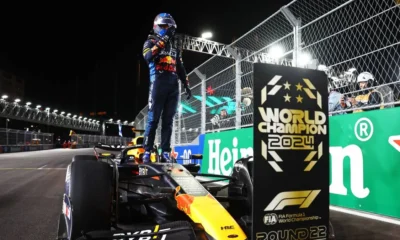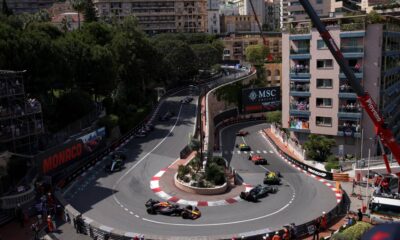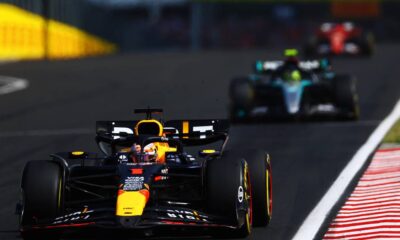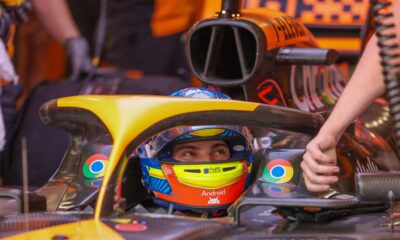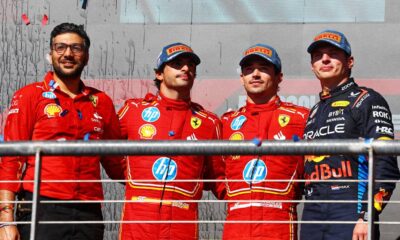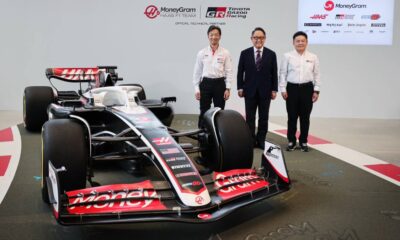More
The return of the mythical ground effect or completely different tyres: what are the most important changes to the technical regulations for the 2022 season?
The new Formula 1 season brings with it the entry into a new era and with it a number of major changes in terms of technical parameters. Why is F1 retaining DRS for the 2022 season? Or how different will the behaviour of 18-inch tyres be compared to 13-inch tyres? The mythical ground effect also returns to the queen of motorsport, so let’s take a look at the most significant technical changes together.
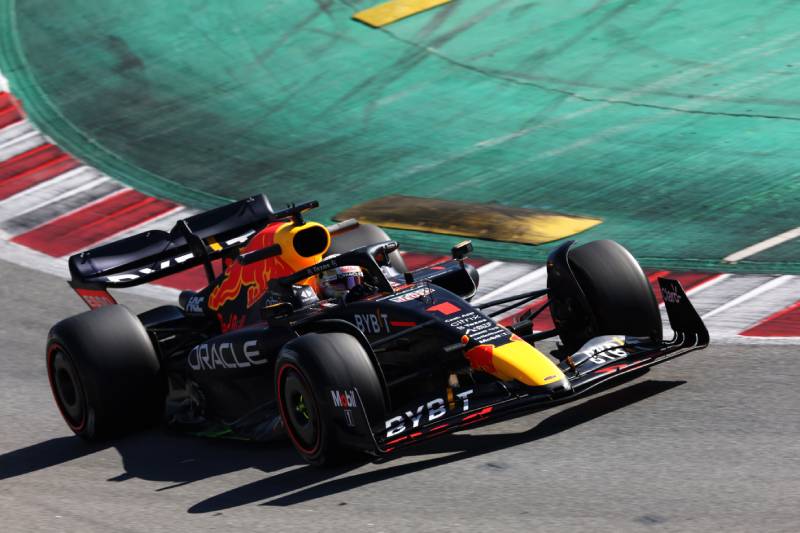
The new Formula 1 season brings with it the entry into a new era and with it a number of major changes in terms of technical parameters. Why is F1 retaining DRS for the 2022 season? Or how different will the behaviour of 18-inch tyres be compared to 13-inch tyres? The mythical ground effect is also returning to the queen of motorsport, so let’s take a look at the most significant technical changes together.
Tyres
Formula 1 says goodbye to 13-inch tyres. In fact, these are being replaced in the new era by 18-inch wheels, which should promise much.
Towards the end of last season, drivers tried out the new 2022 monoblocs in simulators, noting on that occasion that it was the larger tyres that made visibility on the race track worse.
Moreover, these fears were finally realised before the tests in Barcelona, specifically at the filming days.
“With these tyres, the visibility on track is a bit different, which I think can be less of a problem on a circuit like this. Then when we go to the city tracks, it makes the racing a little bit more challenging,” Max Verstappen said of the 18-inch tyres in an interview with Motorsport.
But as F1 reports, the old 13-inch tyres were a significant producer of dirty air, resulting in other cars losing up to 46% downforce within ten metres of the monoposto. However, this is set to change with the advent of 18-inch tyres, with the loss of downforce reduced to just 18% at the same distance.
At a distance of 20 metres behind the monopost, the cars were also losing too much downforce, namely 35%. Here the reduction is all the more drastic, because now cars following the monoposto at a distance of 20 metres would lose only 4% of downforce.
The new tyres are also supposed to degrade less, and overheat less. They also offer a larger temperature window, giving teams more options for handling the tyres.
In fact, the tyre covers and the smaller and harder sidewalls (F1 is moving from 170mm to 135mm sidewalls) of the tyres ensure more control in the suspension and set-up of the monopost.
Thanks to the new tyres, teams should not experience any deformation. However, the width remains the same, with the wheels increasing in diameter from the original 660mm to 720mm.
Also new are the mudguards, which you can see in the attached video below, which are located on the front tyres. The hubcaps and mudguards, by the way, are supposed to take care of smoothing airflow.
In the video, you can also notice the warm-up blankets, which are not banned despite F1’s original plans. The 18-inch tyres then respond more accurately to the driver’s instructions. The teams are currently trying to optimise the new technology packages and make the most of the new tyres.
DRS (Drag Reduction System)
The rear wing opening system first appeared in Formula 1 in 2011 and has had a clear intention all along – to simplify overtaking. For 2022 at least, F1 has decided to keep DRS on its monoposts. Why?
For a full explanation, we need to go back to the previous point, the 18-inch tyres. Because, as we write above, they were a significant producer of dirty air. The problem is that once the amount of dirty air produced by the monoposts is reduced, it automatically means a reduction in the effectiveness of the slipstream on the straights.
That’s why Formula 1 keeps a backdoor system in the form of DRS – for the sake of lower slipstreaming. While less turbulence and less dirty air makes it easier to follow the monopost, on the straights the cars won’t get as close because of the lower slipstream efficiency, which is what DRS currently solves.
And this is how DRS is supposed to work in the 2022 season.
Floor and Ground effect
As part of the return of the ground effect to F1, the floor has undergone big changes on the new monoblocks. The flat floor has been replaced by so-called venturi tunnels, which accelerate the airflow under the car, creating a vacuum that pins the car to the track. Hence the term ground effect, or suction effect.
We wrote an article about the ground effect about a year ago, so you can read about its history and why it was banned by the FIA in 1983.
Also, the narrower the rear of the monopost is compared to the front, the faster the car pushes air away, increasing downforce and speed.
This in turn causes much less aerodynamic drag than the downforce generated by the front and rear wings. However, as you will see in the link above, the front and rear wing are still an integral part of the ground effect.
The latter, in the truest sense of the word, is making a comeback in Formula 1 after forty years and also plays no small part in reducing dirty air generation.
However, for this suction effect to work properly, the car needs to be hard and low in its construction. This means that pilots have to be very careful when driving over kerbs, otherwise the floor could be damaged and the monoposto might not function properly with regard to its aerodynamic properties. The construction of the cars themselves is particularly stiffer in terms of set-up than in the previous era.
It should be noted that the so-called reference plane, which served as the lowest point of the floor and prevented teams from shaping the floor in any way, is also disappearing from the floor. However, thanks to the new regulations, shaping is once again possible.
In the 1970s and 1980s, however, teams used a variety of mouldings to prevent the inflow of unwanted air. After that, if there was even the slightest damage to the car, the monoposts immediately started to lose downforce, became harder to handle and therefore dangerous.
No, the return of the ground effect doesn’t really mean that we will see dangerous machines on the track with different slats or curtains. After all, designers today already have the most advanced technology, wind tunnels, and therefore a lot of data at their disposal.
The rear suspension of the monopost will thus be fitted with so-called blades that will seal the rear part of the floor and the diffuser. The location of the blades on the rear suspension ensures that they will always be at the ideal distance from the race track, as they will react to the movement of the wheels, not the bodywork.
Front wing
A major change in the aerodynamics of F1 cars comes in the case of the front and rear wings, which are no longer the main elements with regard to downforce generation. The main point in this respect is the aforementioned floor with venturi tunnels.
By placing the front wing in a higher position, the air flow will be directed mainly to the venturi tunnels in the floor, rather than to the sides of the car, thus again reducing the generation of dirty air.
The front wing is then not only the first point to encounter the choppy air, but it will also direct the flowing air to the sidewalls, from where the air will reach the rear of the car. F1 has also reduced the number of elements on the front wing to four.
The front wing will also be slightly wider, absorbing more energy from a potential impact. You can see the shape of the front wing in the image below.
It’s fair to say that Ferrari’s stable came up with the absolutely brilliant idea of splitting the front pillar in two. In practice, this means that if the crash tests give the team ideal results in terms of absorbing energy from the impact, Ferrari can change the aerodynamic elements on that front pillar as needed without having to crash test again.
This not only makes the front wing work much better, but also saves a great deal of time and especially money.
The rear wing
The rear wing is another important component especially in terms of dirty air production. By removing the sharp edges from the rear wing, it reduces the production of dirty air, which again allows for a better ride behind the monoposto.
In addition, as is customary in a racing environment, the rear wing is usually square in shape for various aerodynamic reasons. However, Formula 1 has moved to a more rounded rear wing due to new technical regulations and ground effect.
Sidewalls
A very important component when it comes to working with the airflow on a Formula 1 monopod. Indeed, these will now be significantly sharper, with large cockpit sidewalls banned for the 2022 season. Instead, the monopod will feature fins of sorts that will take care of directing air into the venturi tunnels.
It should be noted that the shape of the sidewalls is different for each team. At least as far as we could see at the pre-season tests in Barcelona.
The fact remains that the FIA itself didn’t expect the monoposts to be so different in concept.
If we look at the comparison of the actual images we have, Red Bull arrived in Barcelona with the sides falling down and the floor significantly undercut. Williams, on the other hand, have simplified the suspension, but the sidewall openings are much larger.
A rather strange concept from this point of view was set by the Aston Martin engineers, who not only built a very wide car, but also placed ribbing on top of the sidewalls to cool the hot air. How the mechanics will resolve this issue is the big question at the moment.
At lower temperatures it will take quite a long time for the monoposto to warm up because of this ribbing. In that case it is suggested to close or remove this ribbing completely. However, as a result of the closure, there is another problem, namely that the flowing air will behave completely differently again.
This not only shows how different the individual monoposts are, but also shows the very complex work that the designers have to do with the new cars. The tests in Bahrain and the first races will show us a lot more in this respect as well.
Power unit
In 2022, we will see a 1.6-litre hybrid six-cylinder with two regenerative systems in Formula 1 cars, producing around 1,000 horsepower. However, their development is frozen until 2025, with significant changes only allowed due to reliability issues.
The design of the new cars, however, makes the engine sound slightly different again. More robust. However, there is another factor that affects the sound in particular, namely the 10% biofuel (ethanol) content that the new rules require the fuel to contain.
Again, the new fuel burns a little differently and also operates at different temperatures. Formula 1 cars are slightly slower than the previous year because of this. But not by as much as originally expected.
Rear axle
The new regulations also bring changes to the rear axle itself, where the Inerter and third spring disappear and all hydraulic suspension systems will also be banned.
The Inerter and the so-called third element are components that monitor the calibrations of the car itself to maintain optimum height from the ground. The first time the Inerter appeared in Formula One was in the 2005 Spanish Grand Prix, on Kimi Räikkönen’s McLaren.
Thanks to new technical rules, the suspension has also been greatly simplified. This is linked precisely to the advantages of the new tyres, which are stiffer in terms of their construction, while teams should not encounter any deformations. At least not as often as in previous years.
So is it fun for drivers to drive Formula 1 cars?
“Driving F1 cars is always fun. But I remember when the cars were much lighter. That’s the only disadvantage I see in the cars at the moment. I find them too heavy,” said Aston Martin driver Sebastian Vettel, quoted by Motorsport, after testing in Barcelona.
“Apart from the weight, I’m really enjoying this year’s testing. The car is brand new, so you really have to adjust or change your driving style a lot. It’s also interesting for us drivers in terms of having to try new things,” added Charles Leclerc in his assessment of the new cars.
In fact, the new formulae have put on weight, specifically by 43 kilograms (from 752 to 795 kilograms).
So will the drivers and fans be able to overtake more easily thanks to the new cars?
That is still the big question. We will only find out how it will look in practice at the first races. However, the lower efficiency of the slipstream should make up for the retained DRS.
“Less turbulence actually makes it easier to stay behind the other car. You don’t encounter as much loss of downforce or massive understeer or oversteer. But the slipstream effect is definitely less effective. But we’ll have to wait and see for specific results from the race,” said Max Verstappen of the current situation.
F1, Motorsport, McLaren F1 Team, Red Bull Racing, EisKing TV

